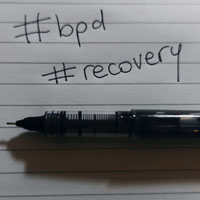Reflective functioning and personal recovery process of users with borderline personality disorder on Instagram: an explorative study using computerized and thematic analysis

Submitted: May 3, 2020
Accepted: September 12, 2020
Published: January 18, 2021
Accepted: September 12, 2020
Abstract Views: 1474
PDF: 633
HTML: 23
HTML: 23
Publisher's note
All claims expressed in this article are solely those of the authors and do not necessarily represent those of their affiliated organizations, or those of the publisher, the editors and the reviewers. Any product that may be evaluated in this article or claim that may be made by its manufacturer is not guaranteed or endorsed by the publisher.
All claims expressed in this article are solely those of the authors and do not necessarily represent those of their affiliated organizations, or those of the publisher, the editors and the reviewers. Any product that may be evaluated in this article or claim that may be made by its manufacturer is not guaranteed or endorsed by the publisher.
Similar Articles
- Guido Giovanardi, Patricia Spangler, Introduction to the Special Section on Working on dreams, from psychotherapy to neuroscience , Research in Psychotherapy: Psychopathology, Process and Outcome: Vol. 24 No. 2 (2021): SPECIAL ISSUE "Working on dreams, from psychotherapy to neuroscience"
- Zelda G. Knight, A re-consideration of interpretation. A relational approach , Research in Psychotherapy: Psychopathology, Process and Outcome: Vol. 24 No. 3 (2021)
- Elham Qanbari Alaee, Omid Saed, Sahel Khakpoor, Reza Ahmadi, Mahsa Ali Mohammadi, Majid Yoosefi Afrashteh, Zekrolah Morovati, The efficacy of transdiagnostic cognitive behavioural therapy on reducing negative affect, anxiety sensitivity and improving perceived control in children with emotional disorders - a randomized controlled trial , Research in Psychotherapy: Psychopathology, Process and Outcome: Vol. 25 No. 1 (2022)
- Zelda Gillian Knight, Living under lockdown in the shadow of the COVID-19 pandemic in South Africa: anxious voices from the unplanned shift to online therapy , Research in Psychotherapy: Psychopathology, Process and Outcome: Vol. 23 No. 3 (2020)
- Stefania Cella, Annarosa Cipriano, Mara Iannaccone, Paolo Cotrufo, Identifying predictors associated with the severity of eating concerns in females with eating disorders , Research in Psychotherapy: Psychopathology, Process and Outcome: Vol. 20 No. 1 (2017)
- Federica Bonazza, Lidia Borghi, Eugenia Cao di San Marco, Kyrie Piscopo, Francesca Bai, Antonella d’Arminio Monforte, Elena Vegni, Psychological outcomes after hospitalization for COVID-19: data from a multidisciplinary follow-up screening program for recovered patients , Research in Psychotherapy: Psychopathology, Process and Outcome: Vol. 23 No. 3 (2020)
- Jung Ki Kim, Eileen M. Crimmins, Age differences in the relationship between threatening and coping mechanisms and preventive behaviors in the time of COVID-19 in the United States: Protection Motivation Theory , Research in Psychotherapy: Psychopathology, Process and Outcome: Vol. 23 No. 3 (2020)
- Andrzej Werbart, Siri Aldèn, Anders Diedrichs, Changes in the anaclitic-introjective personality configurations following psychoanalytic psychotherapy with young adults , Research in Psychotherapy: Psychopathology, Process and Outcome: Vol. 20 No. 1 (2017)
- Annalisa Tanzilli, Mariagrazia Di Giuseppe, Guido Giovanardi, Tommaso Boldrini, Giorgio Caviglia, Ciro Conversano, Vittorio Lingiardi, Mentalization, attachment, and defense mechanisms: a Psychodynamic Diagnostic Manual-2-oriented empirical investigation , Research in Psychotherapy: Psychopathology, Process and Outcome: Vol. 24 No. 1 (2021)
- Michela Gatta, Marta Sisti, Laura Sudati, Marina Miscioscia, Alessandra Simonelli, The Lausanne Trilogue Play within the outcome evaluation in infant mental health: a preliminary report , Research in Psychotherapy: Psychopathology, Process and Outcome: Vol. 19 No. 1 (2016): Special issue on Qualitative and Quantitative Research in Child and Adolescent Psychotherapy: part 2
<< < 10 11 12 13 14 15 16 17 18 19 > >>
You may also start an advanced similarity search for this article.

 https://doi.org/10.4081/ripppo.2020.463
https://doi.org/10.4081/ripppo.2020.463





